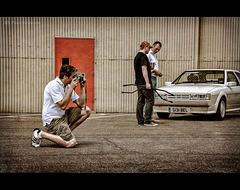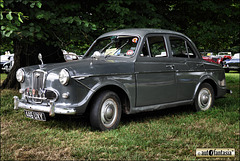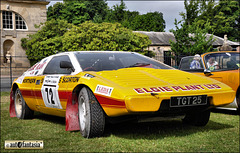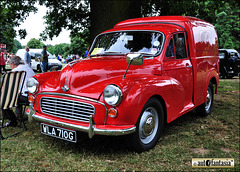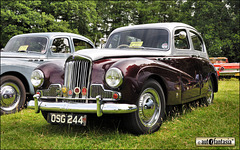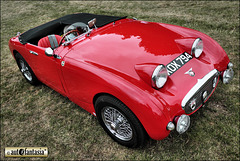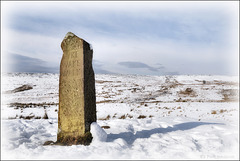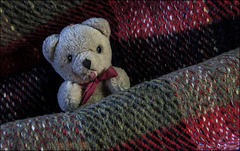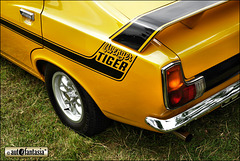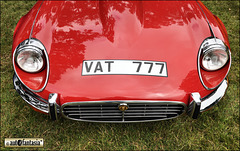autofantasia's photos
More Likely Lads ...
| |
|
|
|
A 'nearly ran' for last week's Sunday Challenge , which had the theme of photographer/s and another dip into the archives given that I'm still time precious.
This one was taken at the Scirocco Register's National Meet held at RAF Cosford way back in 2011. It features Heath on camera duty, whilst Ant considers just how many flies Colin's white MkII 'captured' on the long drive down from Aberdeen and Colin enviously studies Ant's coffee.
Processed using Perfect Effects 9.
The Likely Lads ...
| |
|
|
|
A rather late entry (again) for last week's Sunday Challenge , which had the theme of photographers .
As I'm still very much time precious I had to dip into the archives for this one and had to play around with it in the processing room to get an effect I was anywhere near happy with.
I think interesting is the word you're most likely looking for!
A copy of the original image before it was cropped and processed is now to be found in the Notes for those that like to see these things.
1961 Wolseley 1500 MkII - 446 UXY
| |
|
|
|
What you might call an honest survivor. Not a show winner and far from exceptionally clean, but I admired this little car despite that and in fact it was maybe it's honesty that made it most appealing.
The MkII Wolseley 1500 was introduced in 1960, but the overall style and layout wasn't significantly altered from the earlier MkI.
The most notable development was the more modern look achieved by the boot and bonnet hinges now being hidden. The side chrome trim was also remodelled, losing the circled 'W' and now extending to the front of the car before returning to the wheel arch.
Sadly, the Mk II was short lived, after only a year and a half’s life it was replaced with another slightly improved version: the Wolseley 1500 MkIII.
Source: www.wolseleyownersclub.com
Lotus Elan - WGH 879G
| |
|
|
|
So, you present two women with a front-engined rear-wheel-drive British sporting classic desired by most that come into contact with them and what do they do ... stop for a natter!
(prepares hasty exit stage left ...)
Lotus Esprit - TGT 25
| |
|
|
|
From what I've read online this is built around a Europa chassis with a Rover V8 providing the power.
Originally raced by Dimi Mavropoulos in the late 70s and then in the 80s by Terry Maynard who later restored it for the Goodwood Festival of Speed in 2009.
1990 Vauxhall Nova L - NEV 3S
| |
|
|
|
Staying with the red theme, but this time a much more recent example.
Not a classic some may say, but even this car is now nearly 30 years old and you'd need to look for quite some time to find a cleaner example.
1970 Aston Martin DBS - 3267 TJ
| |
|
|
|
The DBS was produced by Aston Martin from 1967 through until 1972. It was originally intended as the successor to the Aston Martin DB6, but the two actually ran concurrently for three years.
The car famously featured in the 1969 James Bond film "On Her Majesty's Secret Service" and in the 1970s TV show "The Persuaders!" Perhaps somewhat ironically the latter starred Roger Moore as Lord Brett Sinclair who would later go on to play 007 himself.
1969 Morris Minor Van - WLA 710G
| |
|
|
|
Bit of a messy background on this shot, but I thought this old 6 cwt box van was so cool looking that I just had to share it with you guys.
Pilgrim Sumo MkII (AC Cobra Replica) - OHT 804R
| |
|
|
|
Yet another fine example of the benefits of checking out the visitor's car park at any motoring event you attend.
Had I not done so then I'd have missed the opportunity to check out this stunning Cobra replica!
People At Car Shows ...
| |
|
|
|
Not sure if it was her car, but I loved how her outfit complimented the colour and style of the old Pontiac.
And just like the car, a full shot of which you can find in the Notes, her outfit screamed individuality!
Search KBY 282C if you'd like to see more of the Pontiac Catalina.
1956 Sunbeam Talbot - OSG 244
| |
|
|
|
Pretty sure my parents had one of these way back, either before I was born or when I was very, very young.
Which might explain why I've always had a soft sport for them ... simply gorgeous they are.
1959 Austin-Healey Sprite - XOX 794
| |
|
|
|
The Austin-Healey Sprite is a small open sports car, designed by Donald Healey, which was produced in the United Kingdom from 1958 through until 1971.
The little Sprite proved to be hugely popular, quickly becoming affectionately known as the Frogeye in the UK and the Bugeye in the US, because of the manner in which the headlights were prominently mounted on top of the bonnet.
Intended to be a low-cost model that "a chap could keep in his bike shed" the Sprite first went on sale at £669, but something tells me you'd need to pay considerably more to get your hands on this one.
Lost In Space ...
| |
|
|
|
Still not finding much time to take any new shots, apart from the occasional walk-a-bout, or to contribute to The Sunday Challenge so having to mainly content myself with playing around in the 'processing room'.
The original shot on which this is based can be found in the Notes although you might find it hard to believe that this all came from a single macro shot of some rusty old metal, but it did ... honest!
Please view large on black for best effect.
Free Texture 001
| |
|
|
|
Just a macro of some rusty old metal. Feel free to use creatively as you so wish for textures or backgrounds etc..
Lyke Wake Walk ...
| |
|
|
|
Taken for this week's Sunday Challenge , which had the theme of ice .
Lyke Wake Walk? No, not some weird riddle, but the name given to a forty-mile crossing of the North York Moors.
The walk, which stretches between the villages of Osmotherley in the west and Ravenscar near the east coast, basically follows the line of the watershed across the moors at its widest point and at the beginning of the route, only a few yards from Cod Beck Reservoir, stands this impressive stone marker.
The hint that there may be something unusual about this walk though comes from the name: lyke means corpse while wake is the act of watching over it .
So in effect the Lyke Wake Walk commemorates the practice (long since abandoned) of literally carrying the bodies of the dead from various points of the moor to their final resting places.
There is no official route and so those attempting the crossing are apparently at liberty to choose their own way between the start and finish points. The aim of most people undertaking the walk is to complete it within 24 hours so that they then qualify for admission to the Lyke Wake Club .
Those that achieve this are then also allowed to declare themselves either a dirger (men) or a witch (women). Oh, and just in case you're wondering, yes some walkers immerse themselves in the traditions and not only dress as undertakers, but some even carry a coffin too albeit an empty one!
It was actually the late Bill Cowley who originated the concept of the walk when he published an open challenge in the Dalesman magazine way back in August 1955 to cross the moors on foot from West to East within 24 hours. At noon on 1st October that year, 11 men and 3 women set out to perform a crossing reaching Ravenscar around 10.30 the next day and so the Lyke Wake Club was born.
The moors ... they do funny things to you at times!
Good Luck Bear ...
| |
|
|
|
Way back in 1986, when I was in my early Twenties, I was struck down by a rare blood disorder called idiopathic thrombocytopenic purpura or ITP for short. It is an autoimmune disorder which causes a shortage of platelets and today is more often referred to as immune thrombocytopenia.
The immune system basically mistakes the platelets as being foreign and destroys them. It can follow a virus, vaccination or certain medications, but for most people the cause is unknown and that was certainly the case for me.
Platelets, which are small and sticky and circulate in the bloodstream provide the initial plug to stop bruising and bleeding after an injury. A normal platelet count is somewhere between 150 to 400 (x 109/l) and anyone with a count less than 100 (referred to as 100,000 in the US) would be considered thrombocytopenic (i.e. short of platelets).
When I was first rushed into hospital following what I'd thought to be a routine blood test my own platelet count was in single figures and so I was at severe risk. Over the coming months I spent more time in hospital than I did out of it and despite the medical staff trying all the usual treatments, such as steroids and platelet transfusions, my counts remained dangerously low throughout that period.
Occasionally, if they rallied up to or around 100 mark I would be let out for a few days, but my counts continued to dip erratically and so I kept ending up having to go back into hospital. It was an extremely difficult, unpleasant and worrying time in my life and very difficult to cope with.
Remember I was only 22 when first diagnosed and there were no mobile phones, tablet computers or internet to help keep my mind of my situation. Thankfully, I had my girlfriend Jan (now my wife) there for support and she would visit every day, sometimes several times a day in an attempt to keep my spirits up.
During one of her early visits she brought me the little teddy bear that you see in this photo to serve as a good luck charm and to watch over me when she wasn't there.
I inserted him into the top pocket of my pyjama jacket and so he was christened Joey, after the baby kangaroos that spend much of their early life inside their parent's pouch.
He and I became almost inseparable during that time and whilst there is no way or proving he made a difference I certainly took comfort from having him around.
Probably my lowest point was at the end of 1986 when I spent New Year's Eve in hospital yet again. I'd started bleeding internally and was sat there all alone with my non-alcoholic lager, my piece of shortbread and with a drip attached to each arm: one for blood and the other for platelets.
I didn’t know what 1987 would bring, but I was sure I wouldn't be around to see much of it and, although the consultants didn’t say so at the time, I later found out that they’d been thinking the same thing.
Within days though, for no apparent reason my counts rose to a level where I could be operated on and so an emergency operation took place to remove my spleen, which was a sort of last gasp attempt at getting my condition under control. Thankfully, that course of action seemed to sort things out as my counts continued to rise and I was discharged from hospital and the clinic for good.
Then in 2009, having gone 23 years without any problems my ITP returned and I found myself with a single figure count and back in hospital. That was strange enough in itself, but even stranger was the fact that second time around I responded favourably to steroid treatment, whereas they didn't work at all back in the Eighties, and so my stay in hospital was fairly brief.
And I'm pleased to say there's been no sign of it returning since then, but maybe I'll just go knock on some wood and give Joey a rub just to be on the safe side!
For this week's Sunday Challenge for which we were asked to share a symbol or object that means something to you and tell us why .
1972 Hillman Avenger Tiger - JBU 737L
| |
|
|
|
Detail shot showing the graphics on the rear quarter of the Hillman Avenger Tiger from earlier.
1973 Jaguar E-Type Series 3 - VAT 777
| |
|
|
|
This one is for Ann ...
The E-Type Series 3 was introduced in 1971, with a new 5.3 L twelve-cylinder Jaguar V12 engine, uprated brakes and standard power steering. The brand new V12 engine was originally developed for the Le Mans series and the final engine could supposedly propel this 'big cat' from 0-60 mph in less than 7 seconds.
The short wheelbase FHC body style was discontinued and so the V12 was available only as a convertible and 2+2 coupé. The newly used longer wheelbase now offered significantly more room in all directions. The Series 3 is easily identifiable by the large cross-slatted front grille, flared wheel arches, wider tyres, four exhaust tips and a badge on the rear that proclaims it to be a V12.
Source: en.wikipedia.org/wiki/Jaguar_E-Type

